Ivory Coast: Land of Masks and Dance Tour Report 2023
18 February 2023
























































































































A Dozo man licks a live ember during a medicinal / healing demonstration (image by Inger Vandyke)
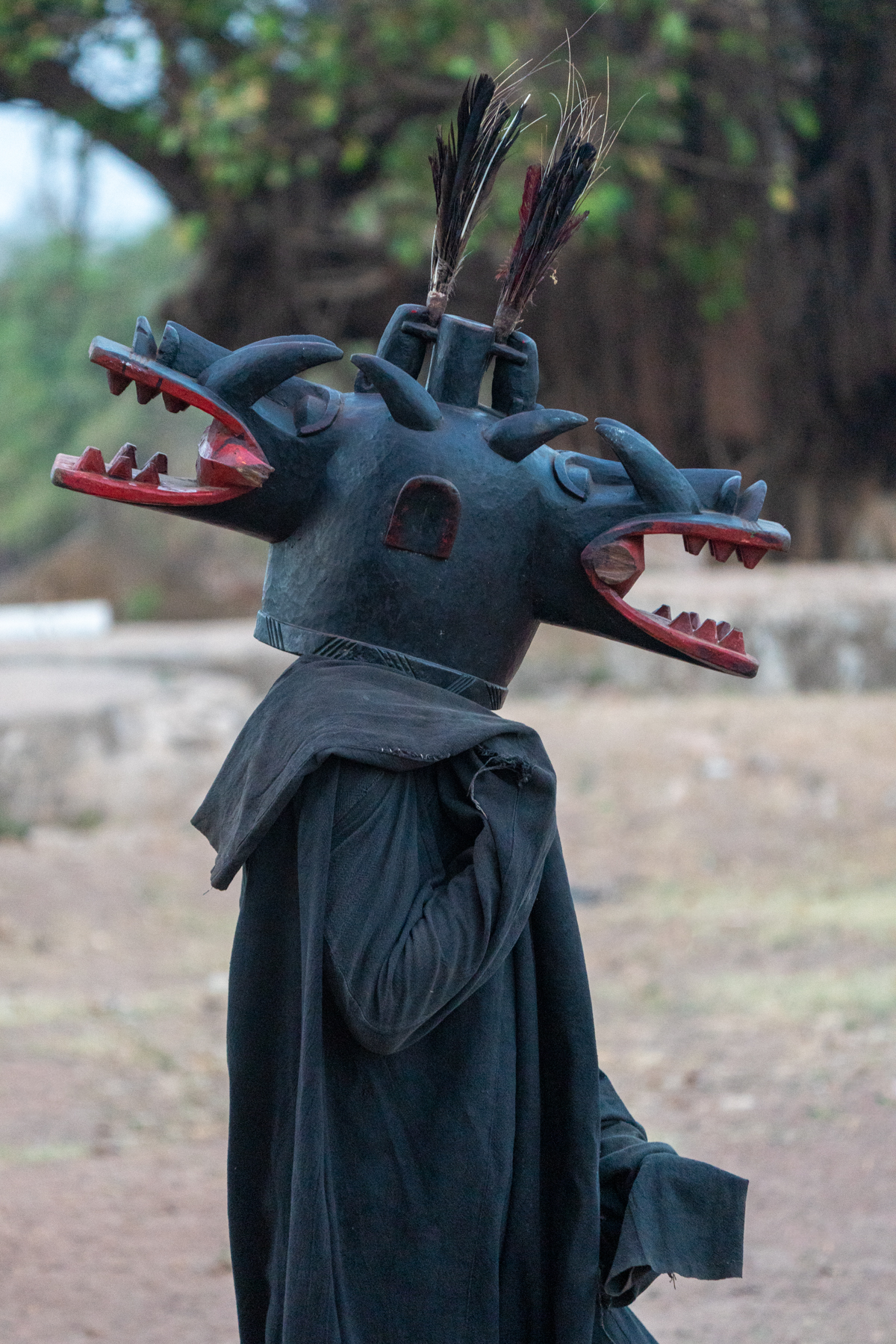
The magical Wambelé (image by Inger Vandyke)

A beautiful Komian girl in blue (image by Inger Vandyke)

One of the Banko washers toiling away next to the Banko National Park in Abidjan (image by Inger Vandyke)

Visiting a Fulani village and meeting such warm and friendly people is always a highlight of tours in West Africa (image by Inger Vandyke)

The incredible Zaouli dance of the Gouro people in Ivory Coast (image by Inger Vandyke)

A Jongleurs dancer sitting in the crowd at her ceremony (image by Inger Vandyke)

Mid-air Boloye Dancer (image by Inger Vandyke)

Balafon performers (image by Inger Vandyke)

Seated Wambelé dancer with his mask. It is unusual to see who is behind the masked dancers of West Africa. Wambelé is the exception (image by Inger Vandyke)

After making a sacrifice you can visit fortune tellers to find out if your wishes will come true at Mont Sienlow (image by Inger Vandyke)

The home complex of the Niofoin Fetish houses include a building for cooking (centre) and a Kafodan, or meeting building (left) (image by Inger Vandyke)
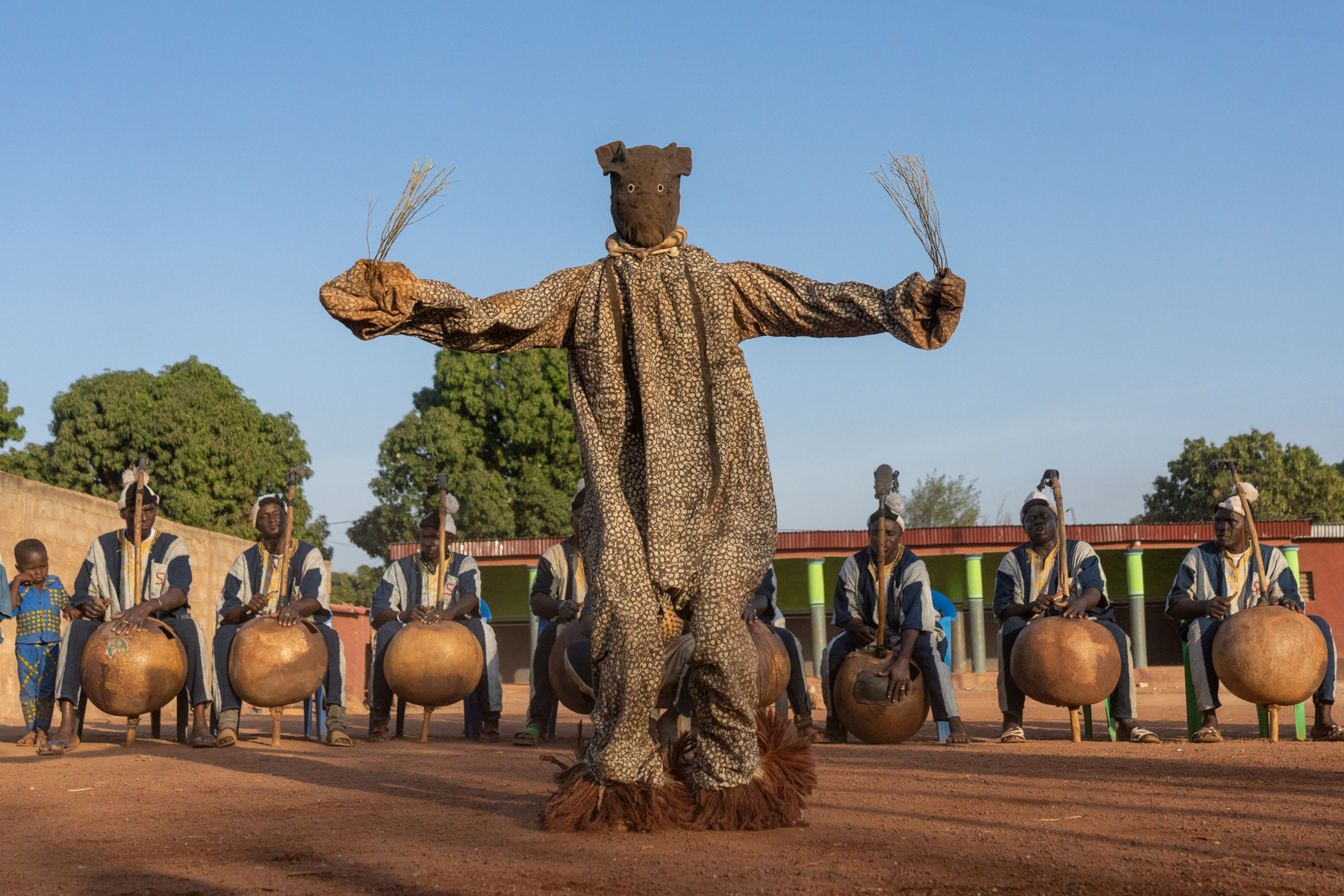
Boloye with his ceremonial twigs (image by Inger Vandyke)

Shea Butter seeds must be washed thoroughly before they are boiled (image by Inger Vandyke)
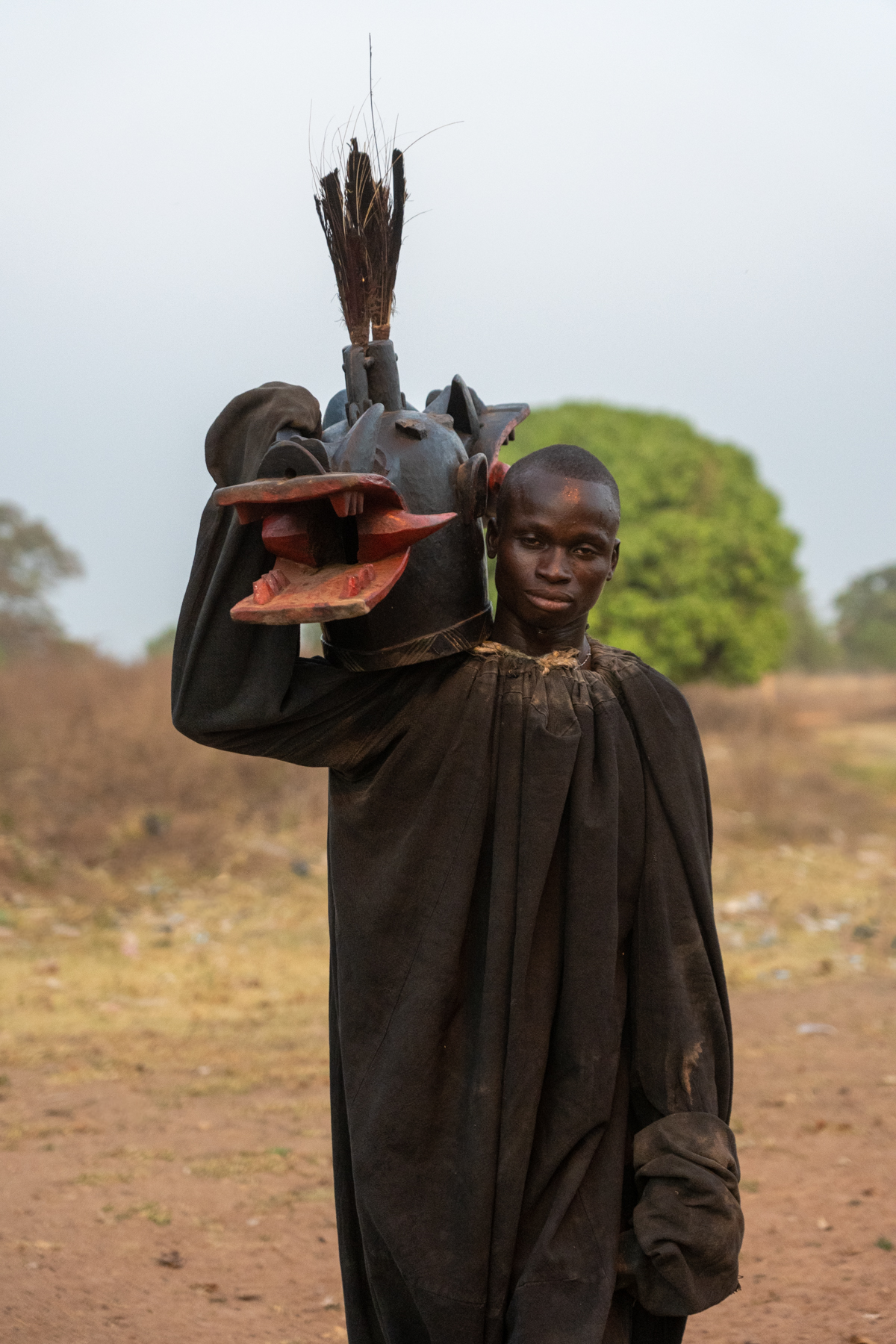
The mysteries Wambelé, or the sorcerer in Senoufo culture (image by Inger Vandyke)

The master of ceremonies who presides over the Yacouba Godoufou ceremony (image by Inger Vandyke)

A typical village scene in Yacouba territory (image by Inger Vandyke)

A Senoufo blacksmith shows us how he picks up metal from the earth using a magnet (image by Inger Vandyke)

Dozo men take a break in the shade of a sacred rock (image by Inger Vandyke)

A young woman working at a Shea Butter plant in Korhogo (image by Inger Vandyke)

Senoufo virgins at N'Goron ceremony in remote Ivory Coast (image by Inger Vandyke)

Gba takes a moment to rest (image by Inger Vandyke)

The small and beautiful ancient mosque of Missiridena (image by Inger Vandyke)

The breathtaking stature of a Dozo head man (image by Inger Vandyke)

Gla dancer of the Guéré people in remote Ivory Coast (image by Inger Vandyke)

Portrait of a young Balafon musician (image by Inger Vandyke)

Komian dancer on white (image by Inger Vandyke)
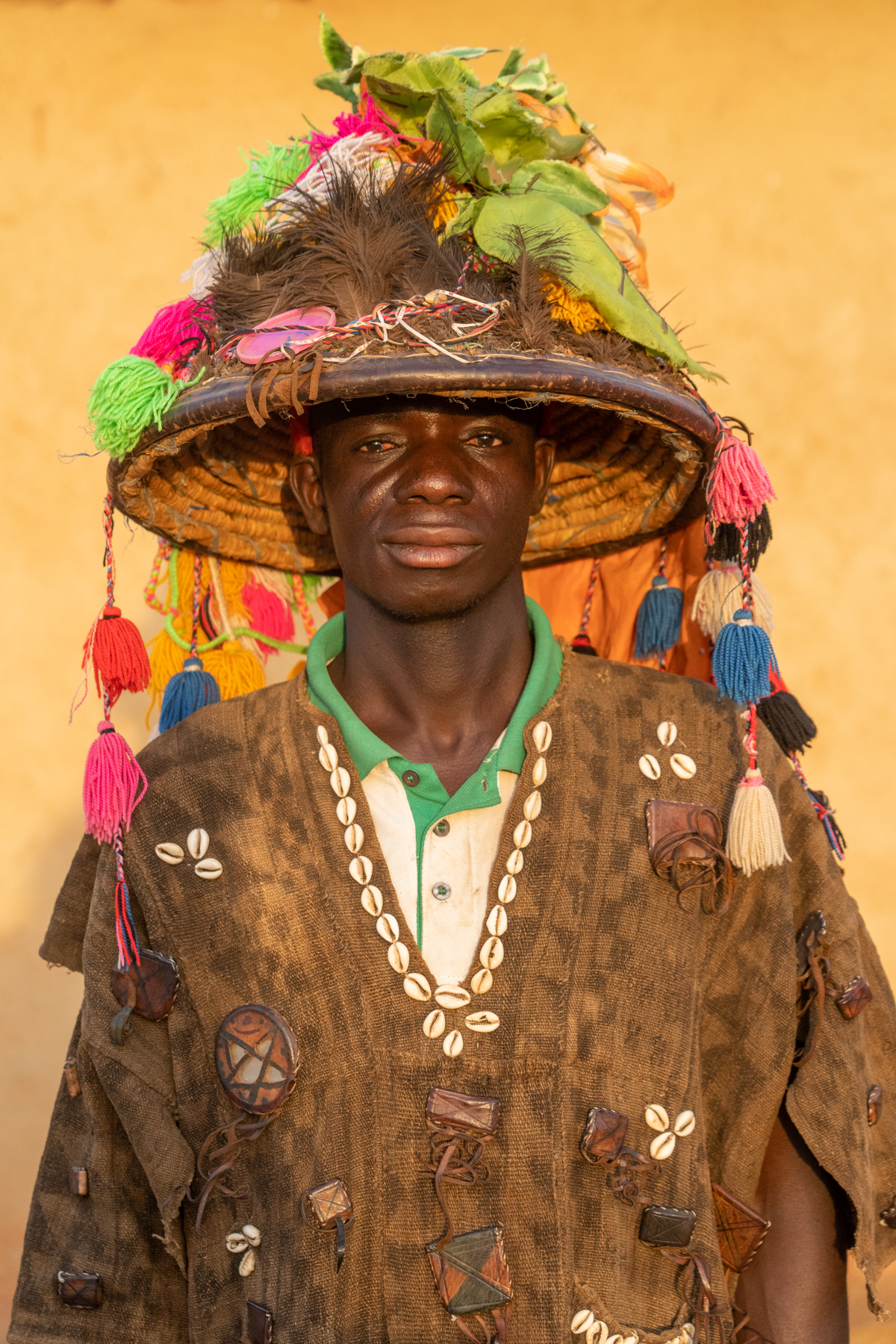
A young Dozo man in attendance at N'Goron, the ceremony of fire for young Senoufo virgins (image by Inger Vandyke)

The crazy Gla dancers of Ivory Coast's Guéré people (image by Inger Vandyke)

Gba in hiding (image by Inger Vandyke)

One of the stick musicians performing at the ceremony of Gba (image by Inger Vandyke)

The stained glass windows of St Pauls tell the story of Christianity's introduction to the Ivory Coast (image by Inger Vandyke)

Too close for comfort? A Boloye lands right in front of us during a dance (image by Inger Vandyke)

Local art in the ruined artists' building at Grand Bassam (image by Inger Vandyke)

Dozo musicians and their koras at the base of their sacred mountain (image by Inger Vandyke)

Zaouli dancing with his guardian (image by Inger Vandyke)

Koma in action (image by Inger Vandyke)

Bead making by hand in Korhogo (image by Inger Vandyke)
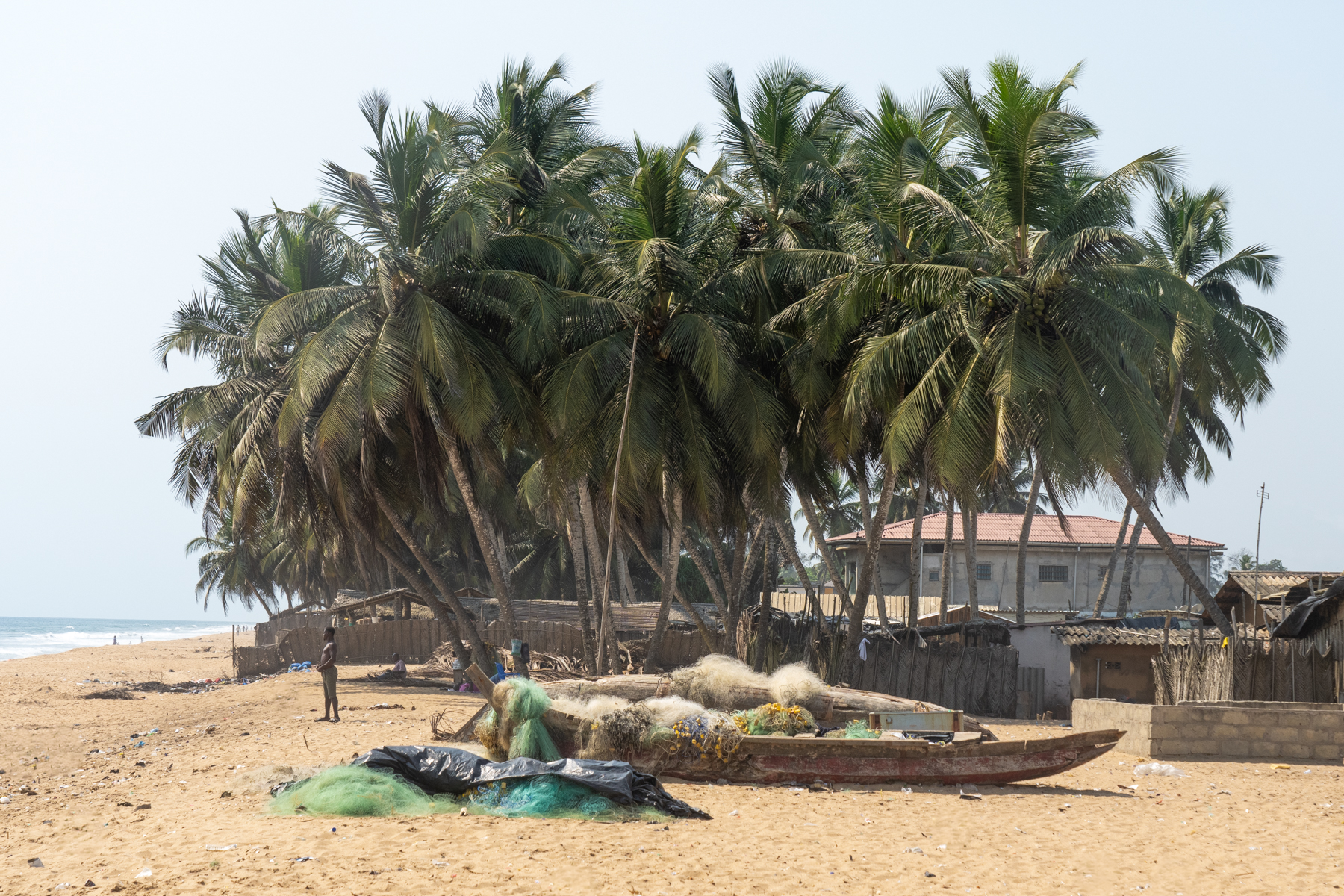
The fishing village at Grand Bassam. With luck it will be protected as part of the UNESCO listing for the area and not ruined by modern development (image by Inger Vandyke)

Bas relief details on the outside walls of the mysterious Niofoin Fetish Houses (image by Inger Vandyke)

A crazy Boloye dancer puts on a wild act in Ivory Coast (image by Inger Vandyke)

Hand painted cloth for sale in Grand Bassam (image by Inger Vandyke)

Beautiful Goly dancers of the Baoulé people in Ivory Coast (image by Inger Vandyke)

The hands of a fortune teller at Mont Sienlow (image by Inger Vandyke)

Yacouba head woman in attendance at the stilt dance of Godoufou (image by Inger Vandyke)

Detail of the Dozo funerary dress. It is made from leather, stitched with cowrie shells (image by Inger Vandyke)

Missiriba is one of the best preserved mud mosques outside of Mali in Africa (image by Inger Vandyke)

Young Senoufo men dancing at N'Goron (image by Inger Vandyke)

Amazing Gba. He was a group favourite during our tour (image by Inger Vandyke)

The brutalist architecture of St Paul's cathedral in Abidjan. The building was meant to be in the shape of an elephant! (image by Inger Vandyke)

A beautiful Sooty Mangabey at the monkey sanctuary in Man (image by Inger Vandyke)

The magical Wambelé (image by Inger Vandyke)

Wild Boloye dancer somersaulting in mid-air (image by Inger Vandyke)

Portrait of a Balafon musician (image by Inger Vandyke)

Detail of a Gla mask (image by Inger Vandyke)

Twirling Gba was one of the most charismatic dancers we met on our tour (image by Inger Vandyke)

Inside the Komian shrine (image by Inger Vandyke)

A Senoufo virgin wtih traditional headdress at the ceremony of N'Goron (image by Inger Vandyke)

An elderly Senoufo woman spinning cotton in the door of her home (image by Inger Vandyke)

Inside Missiriba, which is open to both men and women for prayer (image by Inger Vandyke)

Motion blur of a Zaouli, one of Africa's most famous dancers (image by Inger Vandyke)

The selection of masks for sale at an obscure shop in Man (image by Inger Vandyke)

A Senoufo blacksmith leans back from the smoke emanating from a metal smelter (image by Inger Vandyke)

Portrait of a beautiful young Fulani girl in the doorway of her home (image by Inger Vandyke)

Gba takes a moment to think about what he will surprise us with next (image by Inger Vandyke)

A spinning Godoufou stilt dancer chases the crowd into the dust (image by Inger Vandyke)

Midday is a time for mothers to sleep but babies never do! (image by Inger Vandyke)

Komian women dowse themselves in kaolin powder to prepare for a ceremony (image by Inger Vandyke)

A Boloye hand stands during a ceremony (image by Inger Vandyke)

Goly masked dancers with their bushbuck skins (image by Inger Vandyke)

Zaouli in the clouds (image by Inger Vandyke)

Stained glass bull in St Paul's Cathedral of Abidjan (image by Inger Vandyke)

The Mont Sienlow sacrificial rock is the most prominent of its kind in Ivory Coast (image by Inger Vandyke)

Aerial view of a traditional Yacouba village with modern buildings creeping in (image by Inger Vandyke)

Balafon dancers spring to life in the ceremony of the same name (image by Inger Vandyke)

Koma takes a rest between stints of amusing the crowd at Godoufou (image by Inger Vandyke)

Portrait of a Boloye dancer (image by Inger Vandyke)

The head girl of the Godoufou. Her role is to prepare young Yacouba girls for their deportment (image by Inger Vandyke)

Portrait of a muslim woman with a large gourd at Kong, northern Ivory Coast (image by Inger Vandyke)

Close up of a Goly mask (image by Inger Vandyke)

Goly dancers standing with their guardian dressed in the traditional Kita fabric of the Baoulé people (image by Inger Vandyke)

Dozo musicians with their traditional Bolon musical instruments (image by Inger Vandyke)

A cheeky Green Monkey at the sanctuary in Man (image by Inger Vandyke)

Gba pouring a libation in the soil. Afterwards we were invited to daub our foreheads with the mud as a blessing (image by Inger Vandyke)

Portrait of a decorated Jongleurs girl (image by Inger Vandyke)

Boloye musicians (image by Inger Vandyke)

A local woman takes a break in the fish market of Abidjan (image by Inger Vandyke)

A Wambelé dancer at his ceremony (Image by Inger Vandyke)
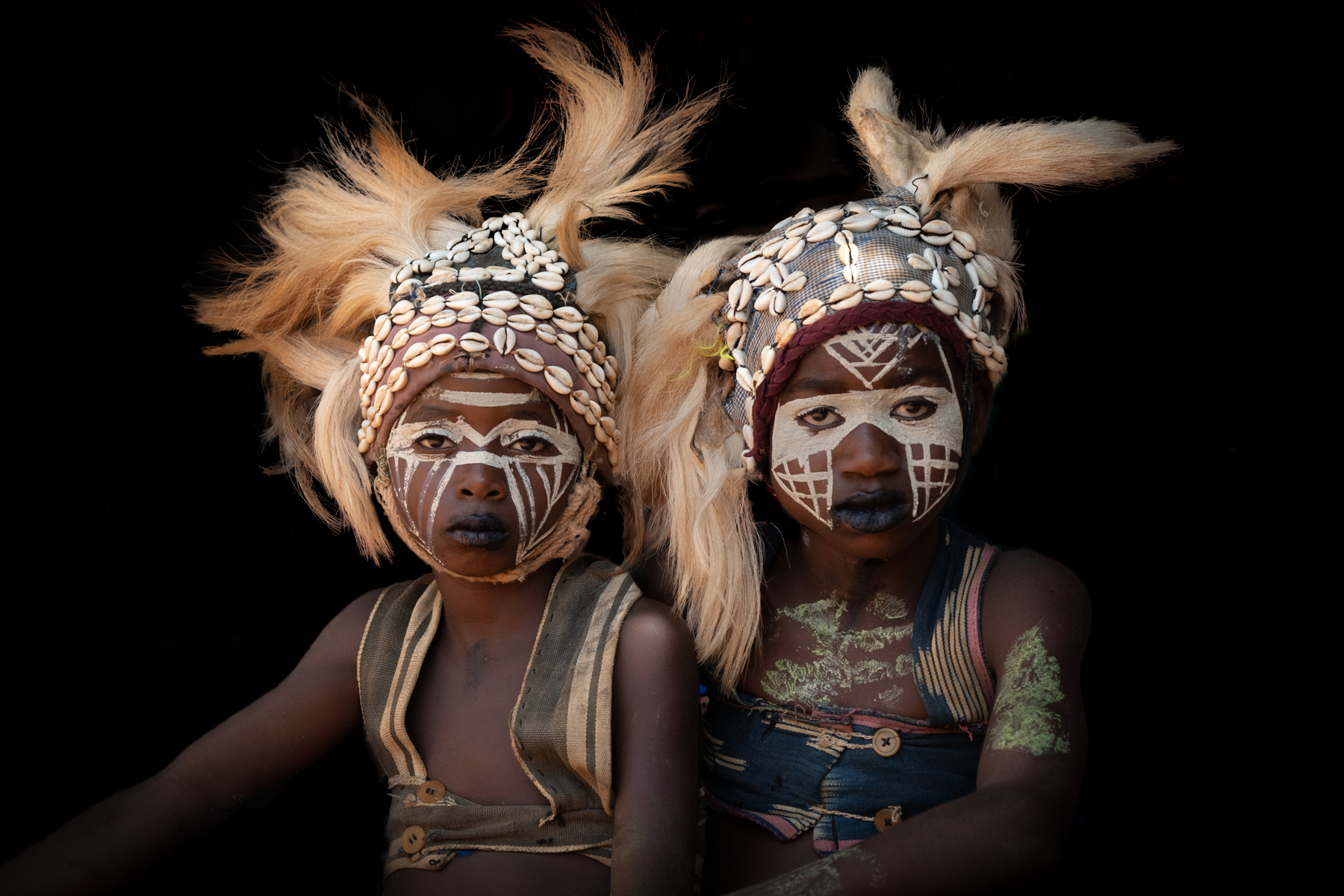
Stunningly decorated Jongleurs girls (image by Inger Vandyke)

Portrait of a Dozo man with protective amulets (image by Inger Vandyke)

The turret of Missiriba (image by Inger Vandyke)

The stilted granaries adorn a traditional Senoufo village (image by Inger Vandyke)

The whip master sitting in a live fire at the ceremony of N'Goron (image by Inger Vandyke)

The small shrine used by the fortune tellers at Mont Sienlow (image by Inger Vandyke)
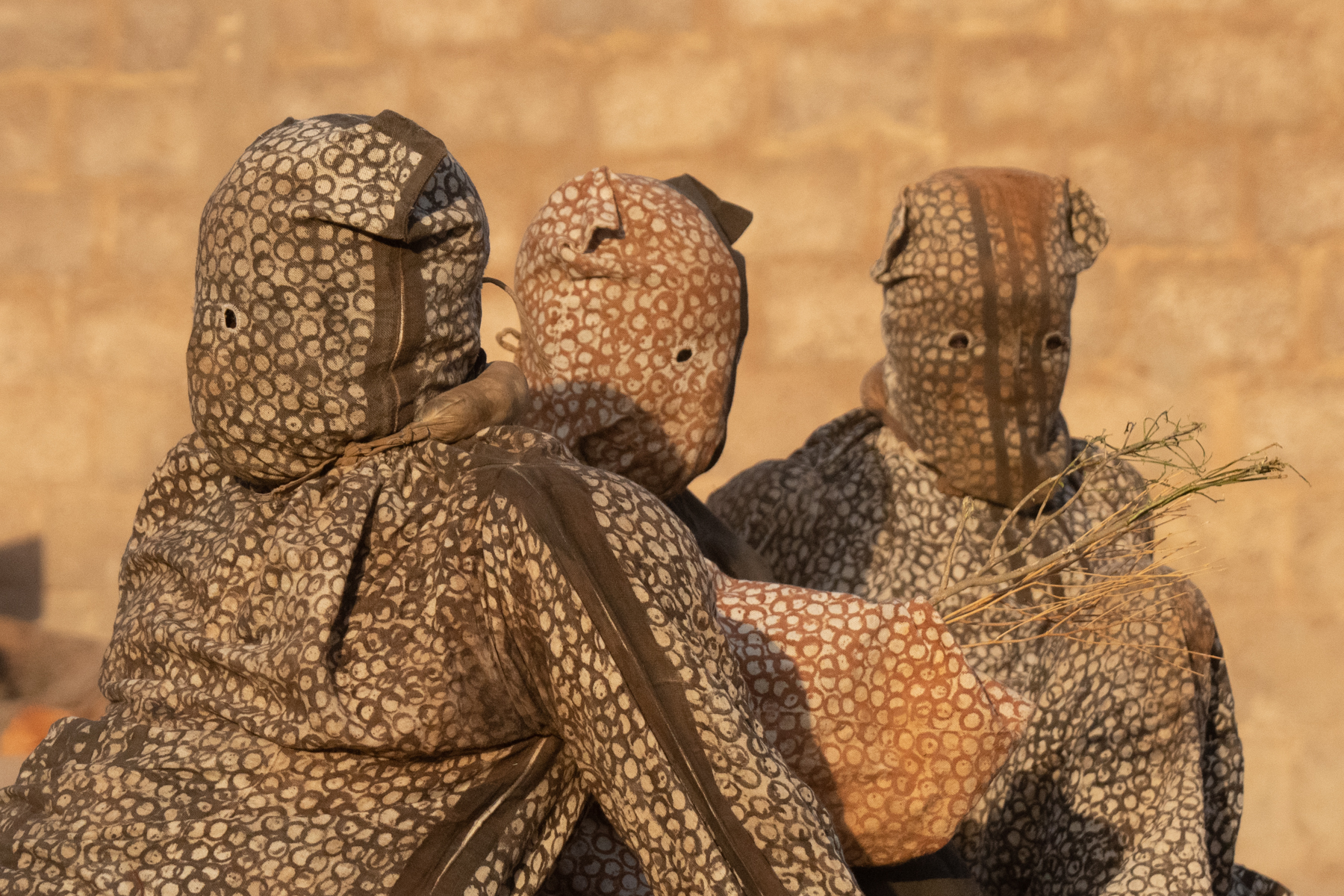
A group of masked Boloye dancers take a break between performances (image by Inger Vandyke)

Godoufou taking in the sunset (image by Inger Vandyke)

Portrait of a Dozo elder (image by Inger Vandyke)
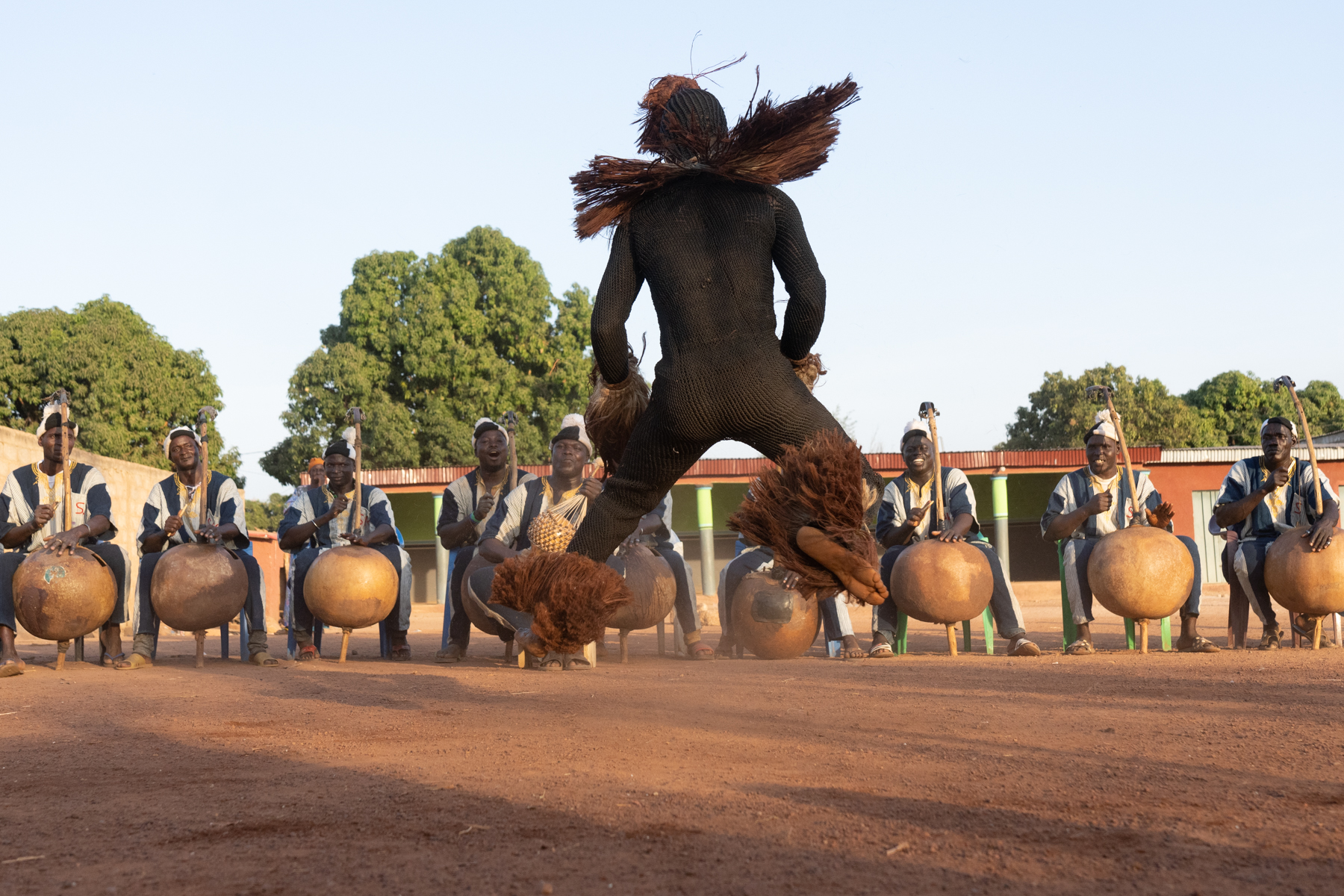
Dressed in black, a Boloye dancer takes flight during the ceremony of the same name (image by Inger Vandyke)

A selection of masks for sale in Korhogo (image by Inger Vandyke)

Portrait of a fortune teller at Mont Sienlow (image by Inger Vandyke)

Detail of a Goly dancer's hands (image by Inger Vandyke)

Hand made and hand painted beads at Korhogo (image by Inger Vandyke)

Portrait of an elderly Senoufo blacksmith (image by Inger Vandyke)

Koma and his guardian pause before returning to the sacred forest (image by Inger Vandyke)

Portrait of a Dozo woman (image by Inger Vandyke)

A Wambelé dancer stops beside his mask before imbuing it with magic (image by Inger Vandyke)

A Komian dancer in a cloud of Kaolin powder during a ceremony (image by Inger Vandyke)

Before it is played at a Balafon ceremony, the skin of a drum is 'cured' over an open fire (image by Inger Vandyke)

A spinning Goly dancer (image by Inger Vandyke)

A Dozo man at the base of a sacred rock in remote Ivory Coast (image by Inger Vandyke)

Buying antiques in the old quarter of Bassam is a very special experience (image by Inger Vandyke)

A pair of Komian women, pretty in pink (image by Inger Vandyke)

Goly dancers with their spectacular raffia costumes (image by Inger Vandyke)

Young kids play in front of Missiriba, the grand mosque of Kong (image by Inger Vandyke)

Hilarious Gla dancer posing for us on tour (image by Inger Vandyke)

Muslim women at Missiridena, the women's mosque of Kong (image by Inger Vandyke)

A woman carrying a large gourd near the doorway of Missiridena, the small women's mosque of Kong (image by Inger Vandyke)

One of the murals adorning the home of Ivory Coast's Komians (image by Inger Vandyke)
Ivory Coast. It is one of Africa’s least-known yet fascinating countries. Having only recently (2011) emerged from a vicious civil war, tourism is in its infancy here. Yet, for those willing to brave the journey, Africa’s Ivory Coast offers a sensory overload of ancient, Voltaique cultures, including some of the continent’s most spectacular masked dances.
Wild Images pioneered photography tourism in the Ivory Coast just nine years after the civil war ended, so it was with great delight that I met up with a group of highly intrepid women photographers in Abidjan at the start of our tour there this year.
Similar to the tour I had just finished leading in Benin, we only planned to visit nine ceremonies during my Ivory Coast tour. Serendipitously, we ended up seeing TWELVE during our trip, all of which left us enthralled.
As a result of a highly experienced ground team and a bit of luck and good fortune, our Wild Images tour of the Ivory Coast this year was truly memorable.
Our tour started in the country’s capital, Abidjan and as I’d arrived a day early from Benin, I gathered our other early arrivers for a casual tour of the city that included visiting the cathedral, a local fish market and a good local book store on the Plateau, one of Abidjan’s most affluent suburbs. Finding books with accurate information about Ivorian cultures isn’t very easy so it was good to search one of the biggest stores in Abidjan for anthropological works and some lovely coffee table books about the country. The fish market gave us a good introduction to the daily trade of fish in Abidjan and also a taste of our first locally made alcohol. The cathedral was a somewhat more relaxed scene as we roamed the brutalist architecture (it was meant to be in the shape of an elephant) building with it’s elaborate stained glass windows telling the story of Ivory Coast’s French introduction to the Christian faith.
That night I gathered my entire group for dinner at our hotel with our guide, and we dined in excited anticipation of the trip. Destinations like the Ivory Coast don’t usually attract a lot of mainstream tourists, and over dinner, I got to chat with my guests about all of our travels in offbeat places. If I was excited about the trip before that night, I got even more excited after meeting this amazing group of very intrepid women. It would be an honour to show them around this obscure yet stunningly beautiful country.
We left Abidjan after breakfast and drove to the city of Abengourou, arriving just in time to enjoy lunch at our hotel.
The Palace of King Nana Boa Kouassi
The first stop of the afternoon was a brief visit to the Agni Indenie Royal Palace where we enjoyed a brief tour to learn about Ivory Coast’s Agni people. A sub-culture of the Akan people who originate in Ghana, the Agni migrated to the Ivory Coast in the eighteenth century and their kingdom still endures with the latest in a long line of kings, Nanan Boa Kouassi. It was here that we first learned about another Akan group, the Baoulé, who fled the Ashanti uprising in Ghana with their resident queen Pokou.
Komians
Time was escaping us a little so we had to truncate our palace visit in order to meet a local group of Komian women who were going to perform a ceremony for us in the late afternoon.
Arriving at their complex we were seated in a room designated for invited guests but there was so much going on outside, I politely asked if we could go and watch the preparation for the ceremony. They graciously accepted and we spent some time meeting the assembled crowd in between photographing the Komian shrine and the dancers preparing for the ceremony.
When it began the matriarch of the Komians sprinkled a circle of white kaolin powder around the dance arena to protect the Komians from evil spirits. The performance began and we all enjoyed watching these beautiful women twirl and sprinkle kaolin in their dance. The lead dancer mesmerised us as she appeared to be in a trance, or at least in some separate mental state, and was speaking in tongues. On this occasion we also witnessed Komian men joining the dance and at one point we were all given pieces of wax cloth to wrap around us so we could join in also.
Storm clouds were brewing on the horizon towards the end and we had the honour of photographing two Komian women in portraits before the light faded and we had to retreat from the storm in our car.
Komians are truly a dying culture in Ivory Coast. Traditionally they play the role of medicinal healers and, more importantly, soothsayers. It is thought that an appointed King in the country cannot begin his duties without being blessed by a Komian first.
A few years ago a special school was set up to train young Komians but sadly this has now ended due to one of the main teachers passing away and the ravages of the pandemic.
It is when I experience afternoons like this with my groups that I wonder how long many traditional African cultures will survive in the future.
By the time we reached our hotel for dinner it was dark.
The following day we left Abengourou and drove to Yamassoukro where we enjoyed a lovely lunch at a local restaurant across the street from one of the city’s crocodile lakes.
The Basilica of Our Lady of Peace
After lunch we paid a brief visit to the gigantic Catholic Basilica of our Lady of Peace. Listed by the Guiness Book of Records as the largest church in the world, this huge Basilica was completed in 1990 after taking five years to build it at an estimated cost of between US$175-600 million! The Basilica was originally gifted to the Vatican by the former Ivorian president, Félix Houphouët-Boigny and was consecrated by Pope John Paul II on 10 September 1990. We only really visited the entry of the church as the full tour takes almost two hours and we had the second ceremony of our tour waiting for us around 90 minutes by car from the city.
Zaouli
We arrived in a tiny satellite village of the larger Ivorian town of Bouaflé. It was here we were going to spend the rest of the afternoon visiting perhaps one of the most famous dances in Africa, the Zaouli.
A fairly new dance to the Ivorian cultural scene, Zaouli was listed by UNESCO as part of the intangible heritage of Ivory Coast. It is quite difficult to see this dance if you just show up and expect it (like so many African ceremonies) so we gathered with a group of local people in excitement about seeing it.
The UNESCO World Heritage listed Zaouli is part of the intangible culture of Ivory Coast
What followed was a wild afternoon where we watched several performances of a very famous Zaouli, in between doing some portraits in the private shrine and actually joining in the Zaouli ourselves. Hilariously I don’t think any one of us quite managed to pull off the fancy foot work of Zaouli, but we all shared a lot of laughs trying before we had to finally depart for Yamassoukro as the sun was setting.
We left for a local village of Baoulé people shortly after breakfast the following day. Another sub-culture of Akan people, the Baoulé are best known for their hand woven fabric called “Kita” and also their spectacular masked dance of Goly.
When we arrived in the village we first sought out a good place to watch the ceremony that lent itself to nice photography. It was a little harder than I thought it would be but we settled on a dirt track that separated two local communities.
Goly
So after a few brief visits with the local weavers and photographing some of the local Baoulé people, I caught the arrival of the first pair of Goly dancers out of the corner of my eye. These two raffia dressed dancers with circular masks were guided down to us to perform a wild dance that involved a lot of frenetic twirling and each act ended with the dancer whipping itself with a loud crack!
We ended up watching two different masked dances in between taking portraits of the dancers in front of a rendered wall of a local village house. It was wonderful to share the pride of these dancers with their Baoulé coordinator and the dance guardians. After all, Goly is a truly stunning act of culture and we all found it hard to leave.
The stunning masked dance of Goly, performed by the Baoulé people of Ivory Coast
After stopping to buy some Kita we hit the road and drove north towards Korhogo, the centre of the ancient Senoufo cultural territory.
We experienced a few technical hiccups that afternoon including some issues with the car and a longer than expected lunch stop. Both of these things meant we were running late to see our second ceremony of the day, Wambelé.
Wambelé
In the end it turned out reasonably well that the sun was going down when we arrived. Wambelé represents a magical sorcerer in Senoufo culture and we arrived to see two dancers emerging from a nearby forest with their large wooden, double-faced masks. These masks turned out to be the best masks we were to see on our trip. Each one was the source of much mystery and darkness. Wambelé is an excessively difficult dance to see in Ivory Coast. The Senoufo people don’t generally allow outside guests to watch their magic being performed. If you are blessed enough to see this ceremony, you might find the Wambelé mask spitting fire!
At our ceremony we watched two acts of magic. The first involved the Wambelé mask being lifted off the ground to reveal a small unripe papaya. This was then brought to us and cut open where a metal ring was found inside the fruit!!!
The second act involved us being shown a tiny piece of string. It was then taken to one of the Wambelé dancers who put it in his mouth before he allowed an assistant to pull the string out gradually to a length of around three metres
Wambelé is unusual in that you actually get to see the man underneath the mask. Quite often in African masked dances, seeing the dancer is something that is strictly forbidden.
As the sun was setting and the street lights were switched on we finally caught a chance to get some portraits of the Wambelé dancers with their masks before we had to leave for our hotel to check in.
What a fantastic introduction to the ancient Senoufo culture of Ivory Coast!
Senoufo Culture
The following day we drove out to the head workshop of master Senoufo blacksmith Soro Bé. In Senoufo culture, blacksmiths are not just responsible for creating objects out of molten metal, they are also charged with chasing away the spirits of a dead person at their funeral. We enjoyed watching how metal was procured, melted and fashioned into items including bells, musical instruments, garden and cooking tools while taking portraits of this quite famous blacksmith family.
After we left we had to stop to repair a flat tyre but this was only a quick hold up.
We went back to Korhogo where we spent a little while visiting some mask carvers before heading off to meet some traditional bead makers. Interestingly we saw a group of Poro students who had recently emerged from the forest, wandering the streets of Korhogo. Sadly we didn’t stop but it was fascinating to see these graduates of the Senoufo forest school.
Poro is a series of school periods, each around seven years in duration, where young Senoufo people attend a secret forest school alongside a standard curriculum school, to learn the main tenets of Senoufo culture.
We finally stopped briefly to watch some Senoufo artisans making clay beads and painting each by hand, before we head back into the city for lunch.
After lunch we visited a local poultry market for photography and then we drove out to the otherworldly Mont Sienlow, the most prominent sacrificial site in the country.
Mont Sienlow
When we arrived, we took a small detour on foot to visit a local woman who was gathering cashew fruits and harvesting the nuts that grew beneath each fruit. It was our first taste of eating cashew fruits, a somewhat delicious treat, even if they leave a powdery taste in your mouth afterwards!
As we walked up to the ‘summit’ of Mont Sienlow we noticed that there had been several animal sacrifices already that day and some men were tasked with butchering a cow that had been sacrificed to the spirits.
Wandering around these large koppies, we went to some smaller ones where two of the attendant fortune tellers told one of our guests, Torie, her fortune.
By the time we left the butchering of the cow had finished and we drove back into town to meet up with a local guide at the large cooperative for Korhogo cloth weavers. Most of us bought some Korhogo cloth here and I couldn’t help but pick up a traded piece of Malian Bogolan during this stop. This village was also home to our guide who was due to accompany us to Kong the following day so we met up with him before attending our final event of the day, the incredible Boloye ceremony, or the ‘Panther’ dance of the Senoufo people.
Boloye, The Panther Dance
It’s difficult to put into words the act of Boloye. We arrived to find the usual musicians assembled under a large mango tree. I gently asked if we could move to a more open space and some of them recognised me from my last visit so they said yes.
We started to watch the Boloye dancers arrive in between watching groups of the local kids trying to practice the different moves of the Boloye dance!
In the end we watched around nine Boloye dancers perform for us, each of them dressed in a strange costume that looks like hessian painted with spots that covers their entire bodies, but with small holes cut for their eyes.
This year they were joined by an outlier dancer dressed in a costume of a knitted mask with black tassels. He was no less spectacular, however, and we were all captivated by the incredible mid-air somersaults, backflips and jumps of these amazing dancers, all to the beat of drums and singers, as the sun went down in Korhogo.
A Boloye dancer struts his stuff on our private ceremony
Towards the end of the ceremony I thanked the master of ceremonies for allowing us to witness such a special dance. We saw that one of the dancers had also injured himself during this performance which wasn’t really surprising given the strength required to dance a Boloye.
What a huge, action-packed day and a tremendous introduction to the various facets of Senoufo culture, which is one of the oldest cultures of the Ivory Coast.
The Ancient Mud Mosques of Kong
The following day we drove out to the ancient former capital of trade in northern Ivory Coast, Kong.
Kong is home to two of the most well preserved mud mosques outside of Mali and we enjoyed visits firstly to the larger one, Missiriba, which was open for prayer to both men and women. We enjoyed some photography of the outside of the mosque and its surrounding buildings before being graciously invited to look around inside.
We then went to nearby Missiridena, the smaller mosque devoted entirely to women. Here we wandered around the outside taking photos but sadly, we weren’t allowed to go inside this one. We did meet some lovely local women who happily posed for some photos for us when we asked, however.
Venturing away from this pretty small mosque, we paid a brief visit to a mysterious old house where one of the former Ivory Coast presidents lived, before we left Kong and started our drive back to Korhogo.
En-route we stopped for a lunch of traditional Ivorian food at a small town.
Back in Korhogo we went off to learn how local women create shea butter at another cooperative plant in the city. Well, if any of us doubted the value of shea butter before this visit, none of us did in the end. The process involved local women washing the butter nuts in water before boiling them to remove the oil and then continuously boiling the oil in order to refine it into shea butter. It was all such an arduous process and we bought some small containers of it before we left.
Balafon
Our final event of the day was a traditional ceremony of Balafon.
Balafon is another fantastic Senoufo ceremony that begins with the musicians ‘curing’ the skin of handmade drums over a naked fire. These drums are used alongside the balafon, a xylophone-style instrument that is used in the performance. As we arrived in the small village of the ceremony, we met one balafon player who kindly allowed us to take some portrait photos. We then took a short walk and sat down to wait for the performance to start in a nearby family compound.
As the balafon players arrived crowds of locals gathered with us to watch the ceremony which involved a circle of women dancing in brightly coloured dresses and a series of individual men performing athletic leaps and somersaults to the music.
At the end of it all we took more portraits of the dancers on their own before we drove back into town.
Niofoin Fetish Houses
The next day we enjoyed a visit to the curious Niofoin Fetish houses as our farewell to the Senoufo region of Ivory Coast.
These mysterious small houses never have their roofs replaced each year like so many other African village houses. Instead a new layer of thatch just gets added, lending each a kind of whimsical mushroom like appearance.
The Niofoin houses act as places for sacrifice and the wishes associated with those sacrifices. Outside of each is a wooden building called a Kafodan which acts as a meeting house and judiciary area. No one is allowed to see inside each house other than a very privileged few, so the interior of each fetish house is a complete mystery. Each one of them is decorated in bas reliefs, offerings and the oldest has a hanging set of leashes/collars that remain from the animals that were sacrificed to it.
The Niofoin fetish houses are located in the last remaining true examples of Senoufo vernacular architecture in the country. Dotted between pretty, roundhouse style homes are some chunky, stilted granaries with thatched conical rooves used to keep the contents of the granary dry.
We wandered around these villages photographing the fetish houses, local architecture and some of the residents, including one woman spinning cotton by hand, before we left to drive further south.
Sadly our vehicle issues meant we still had to hobble our car to the town of Boundiali so when we arrived finally, my team went off to get it fixed while we took lunch and a break at the hotel.
Fulani People
When they finally showed up with a fixed car we drove out to a nearby village of settled Fulani people to take photos. Fulanis are not only extremely friendly people but they are also beautiful to photograph. In Ivory Coast you most often see the women selling milk in the markets as they are expert cattle herders. During our visit to their village, most of the men were out tending to their cows so we enjoyed wandering around meeting local Fulani women and girls, some of whom had the trademark Tchoodi tattoos on their bottom lips, and taking photos.
N’Goron
As the sun was going down we left to drive out along a newly created stretch of road to visit our final event of the day – the Senoufo ceremony of N’Goron.
N’Goron is a multi-faceted Senoufo celebration that acts as the initiation rite for young Senoufo virgins. The ceremony begins with the arrival of young Senoufo men who dance and perform ahead of the arrival of the virgins. The overseer of the ceremony is usually a local man who alternates between cracking a large whip to keep the crowd in control, and dancing on an open fire, including placing live embers in his mouth!
The first time I saw this ceremony, it was being presided over by a number of Dozo headmen (more on them later) and this ceremony was no different with Dozos in attendance.
After the ceremony concluded we were once again allowed to take some portraits. Unlike the previous one I’d seen, these girls were wearing the traditional headdress of red cloth stitched with cowrie shells. This older style isn’t often seen in Senoufo culture any more so it was a real privilege to photograph its beauty this time round.
Towards the end of it all we met a really beautiful Fulani girl wandering the village balancing a cooking pot and spoon on her head. We all enjoyed meeting her and taking photos before heading back to our hotel in Boundiali for dinner.
The next morning we drove further south towards the city of Odienne where we met up with an incredible group of Dozo people.
Dozo
Traditionally a hunting fraternity that stems from Mali, Burkina Faso, Liberia and the Ivory Coast, the Dozo people are seen as both guardians of a community and spiritual healers.
As we drove into town our first sign of them was a couple on motorcycles on the road, who guided us to the meeting place.
We then saw this amazing roadside stall selling some incredible black funerary costumes and, oddly, it was those that caught our attention first!
We soon discovered a waiting group of Dozos sitting in the shade of a utilitarian building across the road from this stall.
What drew us to them at first was their beautiful music – a Malian style singer accompanied by Bolon players. We were then invited to join them in the shade while we asked the attending Dozo headman questions about Dozo culture which was a great learning experience for everyone.
After this we enquired if we could take some photos in portrait settings and we all enjoyed this session with a decorated headman in particular. If that hadn’t amazed all of us enough, the Dozo men and women kindly invited us out to their secret forest at the base of their sacred mountain afterwards.
We drove out there in our bus, accompanied by them all on motorcycles and what followed was possibly one of the most amazing highlights of our trip.
We arrived to a short walk through a grove of cashew trees into a stand of native forest where Dozo musicians were playing music for people to dance. Shortly afterwards we were invited to walk up to a sacrificial rock called Dangele (literally means the mother who cradles her only son), which we did. When we reached the top we found two large granite boulders balanced on top of each other. Here we learned more about Dozo culture in between bursts of singing, dancing and portrait photos, before we descended. The Dozo headman must have worried about us going up and down as he stopped to check we were OK on numerous stretches of the hike.
Reaching the forest once more a couple of us hopped up on a large rock to dance with the locals before we were invited to attend the finale dance of our visit.
At this dance we learned how the Dozo people weave their magic, procure water from mango leaves, we tried a natural remedy to stomach upsets and watched how other traditional medicines were created.
During the dance, at one point one of the Dozo men grabbed a live ember from the centre fire and ran it along his tongue!!!! Another did the Wambelé thing of stretching out a long piece of string from the shorter piece in his mouth. In between, some of the men would perform highly energetic dancers.
Towards the end the Dozo headman quietly pressed a cowrie shell gift into my hand ‘for my protection and return’ which I promised to do.
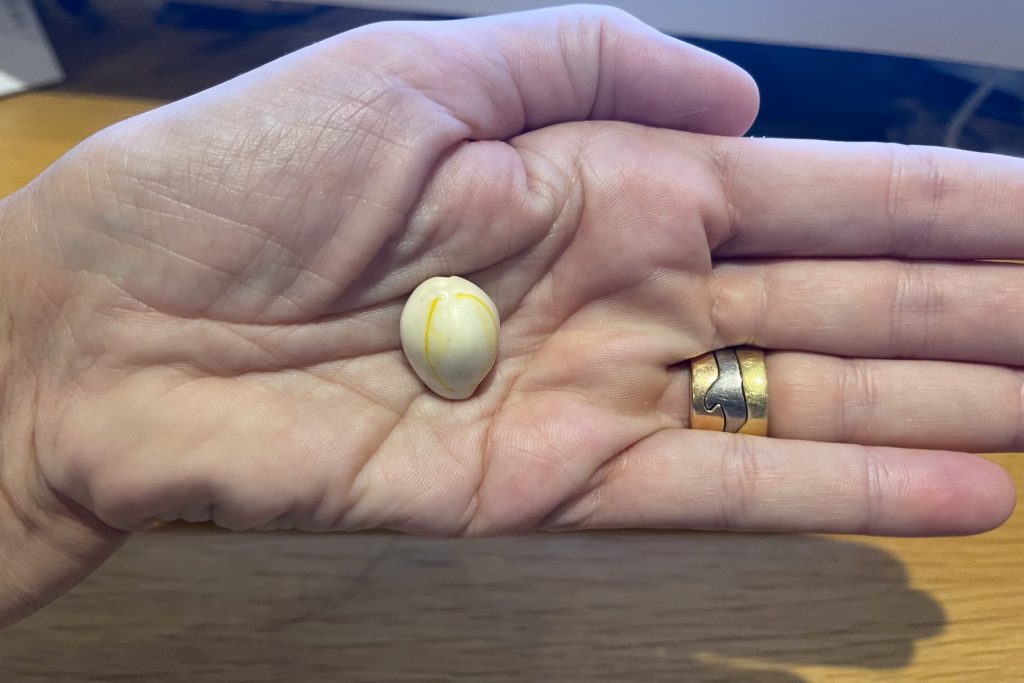
The cowrie shell gifted to Inger by the Dozo headman who so kindly introduced us to his incredible culture (image by Inger Vandyke)
Finally we took the opportunity to photograph the musicians at the base of the mountain before I said a few small speeches on behalf of the group to say goodbye. Then we all, reluctantly, left the forest to drive back to town, following the Dozo people carrying their musical instruments slung across their backs on motorbikes.
Amazing!!!
We finally left Senoufo territory and crossed into the region of Ivory Coast’s Yacouba people.
As we went south we stopped at a lovely restaurant and enjoyed a lunch of delicious fried chicken and fish with Ivorian Atieke, or spiced couscous.
Godoufou
Our final ceremony of the day was beckoning so we drove further south to a traditional Yacouba village where we were to witness a lively performance of Godoufou.
Godoufou is like a finishing school for young Yacouba women. It involves two masked dancers emerging from a nearby sacred forest – one called ‘Koma’ who keeps the crowd entertained and another called ‘Godoufou’ who summons the spirits and dances around on the highest stilts you can imagine while speaking loudly in tongues.
The ceremony began with the local people gathering and separating into gender groups. The young men practiced their gymnastic style dance moves while the women dressed in blue and white to start singing.
In between we wandered around photographing people and homes in the ceremony village.
As the dance started we watched the dance officials assemble and a beautifully painted young girl came out to play the leader of the assembling women. Traditionally she was tasked with preparing young Yacouba women for their initiation into womanhood. Young Yacouba men also started to dance and sing in their own group.
Finally our first masked dancer appeared. Koma was one of the most beautiful masked dancers we saw on the trip. Although he plays a minor role in the ceremony, he is no less important and we watched as he was guided around and welcomed by ceremony officials. As he took breaks each of us approached to take photos of him individually as he was so beautiful.
Then Godoufou arrived on stilts. The main act of the ceremony certainly didn’t disappoint after he was welcomed by the masters of the ceremony. He began to twirl around wildly scattering crowds of the local kids and onlookers who ran off into the dust.
The stilt dancer of Godoufou had all of us completely enthralled
Finally we offered up the ceremony tips, giving the first one to Godoufou. Our donation was placed on the ground and he carefully approached it like he was almost studying it. He then flipped over on his back to pick it up while the crowd cheered him on. He got very excited about his tip and I ended up being invited into the adoring crowd who gave thanks for our other tips all while people paraded around me singing and dancing their thank you songs. It was the most frenetic and beautiful event I think I have ever guided on a tour.
Just when we thought it might all be over, the dancers started moving off with the crowd to return to the sacred forest. We were invited to join in and of course we all did. We were literally buoyed along by over a hundred very grateful and cheerful Yacouba people. Finally we got to photograph Koma before he went into the forest and then the women continued to dance us to our car.
Yacouba people walking Torie and our group back to our car at the end of the Godoufou ceremony
I always remember the first time I came to this village. On that event the ceremony finished when it was dark and the people were so concerned about us that they walked us back to the road in the night darkness. This time round they remembered me from that night and we were shown a royal performance of this iconic dance. What a very special thing to witness on our trip!
That night we drove to the pretty mountain city of Man. Still feeling full from lunch, instead of dinner I met my group for cold beers next to the pool and I cut some fresh, ripe mangos for us all to eat which were delicious.
Man is a multi-ethnic city of Ivory Coast that is home to Yacouba, Guéré and Dan people, all of whom perform some truly spectacular masked dances as part of their cultures.
The next morning we drove out to a remote village to witness two of them – the Danse des Jongleurs and Gla, both ceremonies of the Guéré people. Due to an issue on the road we sadly arrived a little later than I had hoped. Even in the harsher light, however, we enjoyed two amazing performances here.
Danse des Jongleurs
Danse des Jongleurs, of the Dance of the Jugglers, is a ceremony where a man actually juggles a group of young girls in the air by throwing them up and carefully catching them. Each of the girls has beautifully painted faces and they wear a helmet fashioned out of horse hair, red cloth and cowrie shells. Photographing them is usually a highlight of this wondrous ceremony and today’s event was no different.
Gla
Their act was followed by a spectacular masked dance called Gla. During this dance we met around five large masked dancers each performing with a guardian for us. Of all the masks we had seen on the trip these were the biggest and probably the most amusing. At one point one of them lay down on the ground and put his feet up on a stool to take a rest.
While we really enjoyed watching these dancers, we also had a lot of fun doing portraits with one of them at the end. He played up for the cameras with all sorts of funny poses. He was a smaller mask so he could fit on to the balcony that I’d chosen to take photos on. Sadly the larger masks were too big to go to the same spot but we still enjoyed photographing each of them in the same quiet courtyard.
It was hard to leave this dance but we had other events to attend that day so we drove back into Man for lunch of delicious fried fish, Jolof rice and vegetables at a local restaurant.
After lunch we visited a tiny sanctuary for wild monkeys in Man which was home to a small group of Green Monkeys and one large Sooty Mangabey. Monkeys are a source of bush meat in Ivory Coast so it was great to visit this reserve where they are protected. We fed them with our gift of some bananas before continuing with our day.
Our next stop was a traditional mask seller located in a busy township of Man. We had to navigate our way through crowds of people who were attending a funeral in order to find him but when we did, we found a small room packed from wall to wall with masks. We bought one from him and then we made our way back to the car where we drove to our final ceremony of the trip, that of Gba.
Gba
Gba, the wood borer, is one of the key masked dances in Yacouba culture. He is used as a harbinger of war and has the most charismatic, whimsical appeal when he is in ceremony.
We went out to a satellite village of Man to see this ceremony and when we arrived we were asked to be seated before being given a drink of palm wine served in natural gourds.
The ceremony of Gba begins with some uniformed men all singing and dancing with large sticks.
Gba is then brought in by his guardian and the stick musicians. The funny thing about Gba is you never quite knew where he would turn up. He would occasionally disappear into the village and we’d try to follow him, only to find him show up in some very random places we’d never guessed.
When we first saw him we watched him take a local baby into his arms which he walked around with for a while before dangling the baby by his leg to give back to his mother!
At different points during the ceremony the men laid the sticks on an angle for Gba to sit on. At another time, Gba laid down for the stick musicians to walk over him.
Sometime after that, Gba grabbed some of the sticks from the musicians and started throwing them for the musicians to catch.
Gba teasing the crowd and throwing sticks to the musicians!
At the end we watched him pour a libation of palm wine on the soil in front of him and he invited each of us to dab our fingers in the mud and press the mark against our foreheads as his blessing.
It was a fascinating, almost mesmerising way to end the ceremonies of our tour! As a final act Gba actually danced with us to our car and we all were sad to see the end of these exciting performances.
Reeling, we drove back to Man where we stopped by some very nice mask sellers to buy masks and figurines from the various West African cultures we had visited on our trip.
That night , after a stunning red African sunset, we enjoyed dinner under a blanket of stars lighting up the sky.
The following day we faced a very long drive back to Abidjan, only stopping for lunch at a lovely restaurant in Yamassoukro. We arrived back in time and checked into the hotel, giving us all a break and time for a rest before our final dinner with Kerstin, who had to leave the tour early due to work commitments.
After saying a sad farewell to Kerstin we left the following morning for Grand Bassam. We stopped briefly to photograph the Banko washers before doing some shopping in the city and heading to the beach.
The Banko washers are an immigrant community who have walked the streets of Abidjan for decades collecting dirty laundry. They take the laundry to a freshwater lake at the edge of the Banko National Park to wash it, lay it out to dry and return it each day. Consisting mostly of male migrants from Mali and Burkina Faso, the Banko washers are a stalwart and unique facet of city life in Abidjan.
After we finished our visit with them, we went to one of the large Vlisco stores to buy African wax cloth and clothes. Sensing we were doing too much shopping we then went to a local Decathlon store to buy extra bags each to take our things home!
Grand Bassam
We then drove down to Grand Bassam and checked into our delightful beach hotel. I had warned the group that the Italian owner of the hotel had a fantastic boutique on site so we stopped briefly there to do some shopping before heading down to the old Quartier France quarter of Grand Bassam, once one of the largest trading ports in the Gulf of Guinea, for a late lunch on the beach.
As we dined on fresh fish and cold beer we watched traditional pirogues fishing out at sea. Then, when the sun got a little lower I showed my group around some of the old Bassam buildings including Ganamet House, the home of a former Lebanese trader who made his wealth out of trading coffee and cocoa with the Ashanti people of Ghana.
At the end of the day we visited a local craft centre for more shopping!
Well what was intended to be a photography day in Bassam, ended up a little more like a shopping day with some photography thrown in! We visited a number of small shops selling some incredible West African masks and bronze figurines from countries like Burkina Faso.
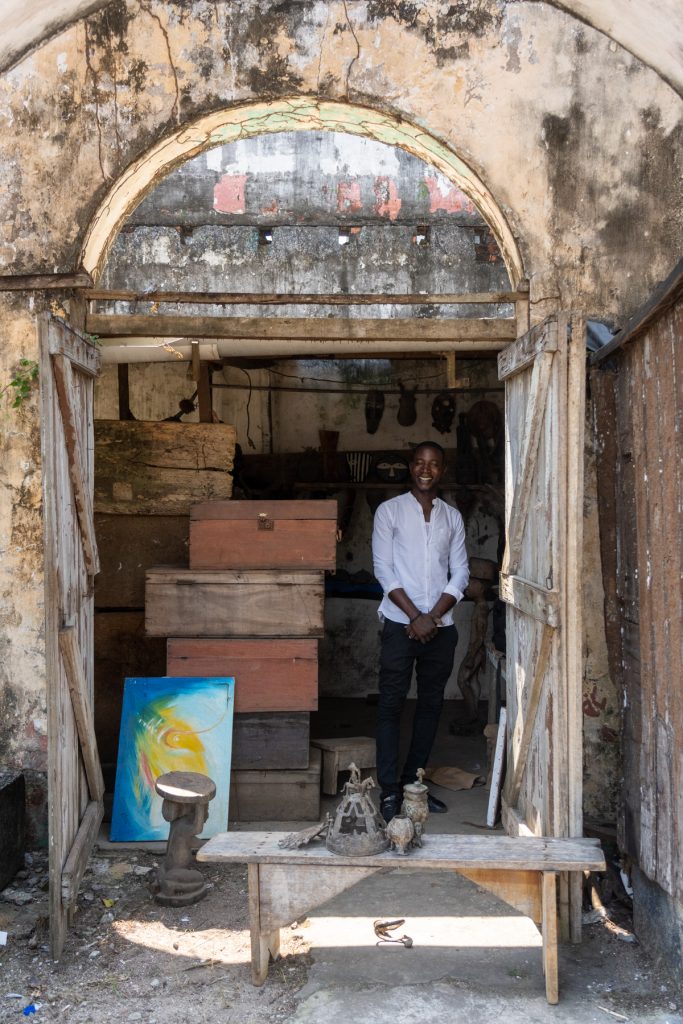
Buying antiques in the old quarter of Bassam is a very special experience (image by Inger Vandyke)
After all buying way more things than I thought we would, we headed to the local fishing village to take photos of the women smoking fish, the men unravelling their fishing nets and children playing in the surf. When the heat of the day became too much, we went off to a lovely restaurant next to a freshwater lake for lunch and playing with the resident cats of the dining room area.
That afternoon we shopped some more and took a break before I made a date with everyone to enjoy a final cocktail on the beach and dinner to celebrate the end of our amazing Ivory Coast tour!
On our final morning of the tour we visited a local brass smelter and fabric printer after a later breakfast. We enjoyed some last minute shopping before heading to the airport where we dropped Nat and Torie off for their flights. I joined Rosalie at an airport hotel for a day stay and we both had a lovely dinner there before I took off to the airport for my late evening flight home.
This was my second tour that I’d led to the Ivory Coast and it certainly won’t be my last. What an amazing place! The wonderful thing about this country is that still so few tourists actually visit it. Although the ceremonies we visited were private to our group, in the end it wouldn’t have mattered as we didn’t really run into other people much during the time we were on the road. I was blessed this time round to have better organisation on the ground and despite a few hiccups with the car and the usual malfunctioning items of basic hotels, we managed to complete the trip without missing a single thing and all of us treated the hiccups with a healthy dose of good humour in the end.
I couldn’t have hoped for a more fantastic group of people to share this momentous tour with and I’m already looking forward to leading my next Ivory Coast trip!z
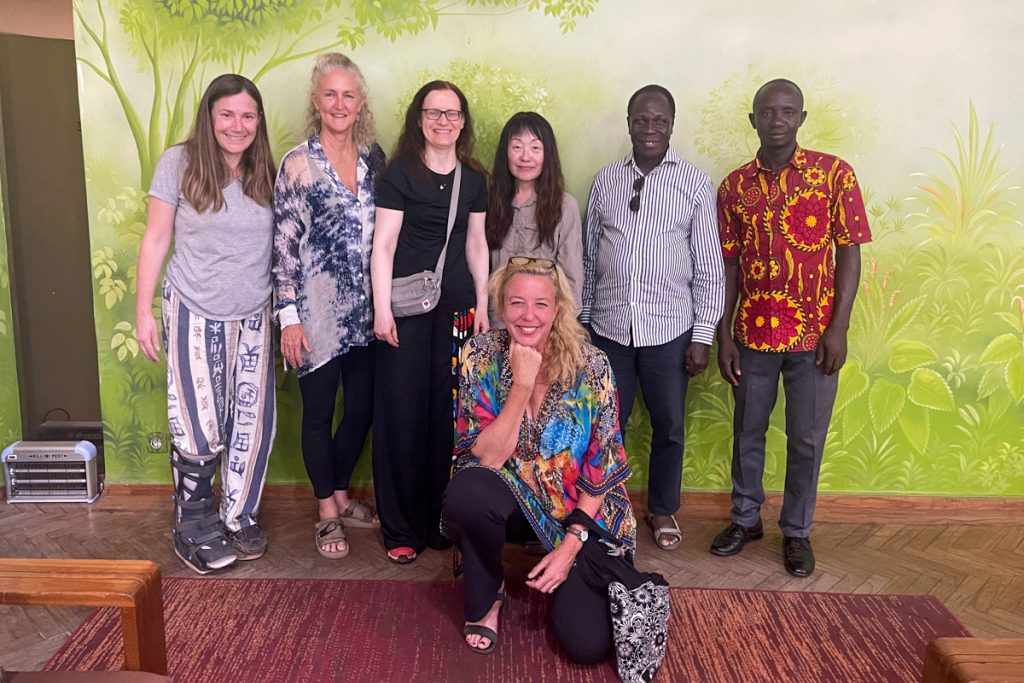
Our 2023 group! What a fantastic bunch of people! (image by Inger Vandyke)
























































































































